Investigation of Barriers: Healthcare Upstream Supply Chain in India
VerifiedAdded on 2020/05/08
|23
|5984
|132
Report
AI Summary
This report investigates the barriers affecting the upstream supply chain in the healthcare sector in India. It begins with a literature review, exploring the supply chain system of the healthcare industry and identifying factors influencing upstream supply chain management, such as supplier relationships, specifications, after-procurement services, compatibility, timely delivery, responsiveness, and safety. The report also delves into issues from a doctor's perspective, including misplacement of medical equipment, late delivery of medicinal products, poor product quality, and lack of sustainability certification. It identifies challenges like lack of awareness, deficient top management support, poorly integrated information systems, and limited communication. The report concludes with recommendations for improving the supply chain management process, such as encouraging top management commitment, enhancing logistic synchronization, improving communication, and staff training, providing a comprehensive analysis of the current state and potential improvements in India's healthcare supply chain.
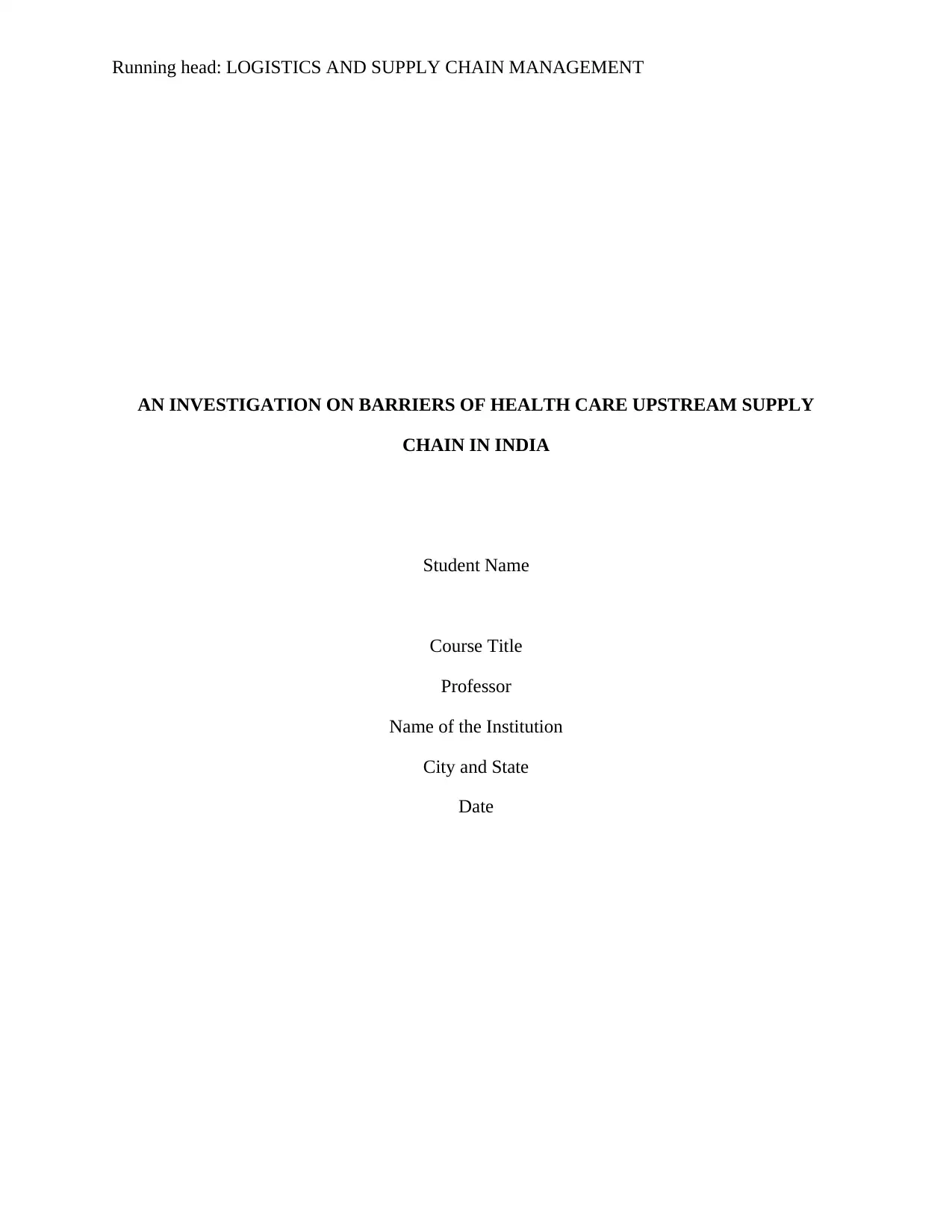
Running head: LOGISTICS AND SUPPLY CHAIN MANAGEMENT
AN INVESTIGATION ON BARRIERS OF HEALTH CARE UPSTREAM SUPPLY
CHAIN IN INDIA
Student Name
Course Title
Professor
Name of the Institution
City and State
Date
AN INVESTIGATION ON BARRIERS OF HEALTH CARE UPSTREAM SUPPLY
CHAIN IN INDIA
Student Name
Course Title
Professor
Name of the Institution
City and State
Date
Paraphrase This Document
Need a fresh take? Get an instant paraphrase of this document with our AI Paraphraser
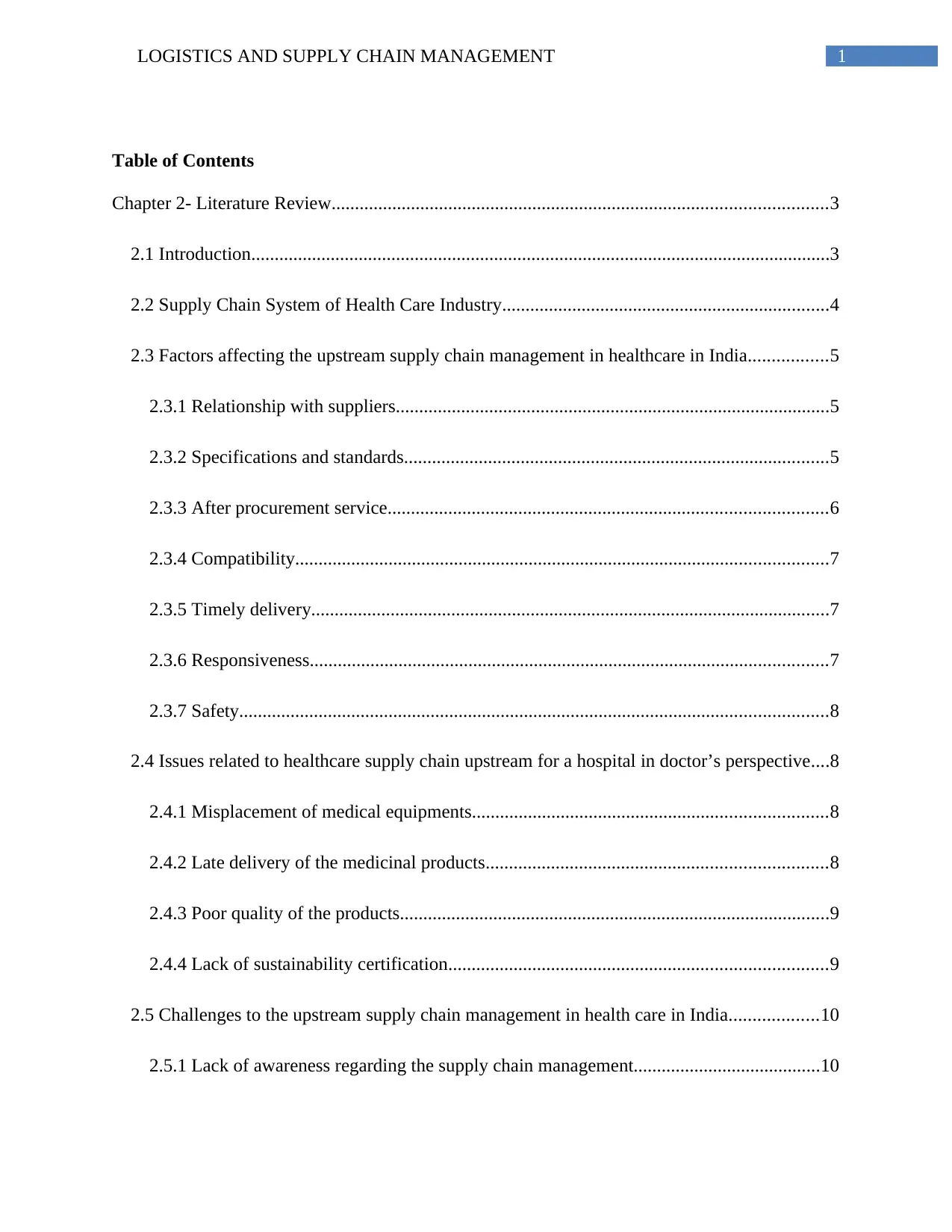
1LOGISTICS AND SUPPLY CHAIN MANAGEMENT
Table of Contents
Chapter 2- Literature Review..........................................................................................................3
2.1 Introduction............................................................................................................................3
2.2 Supply Chain System of Health Care Industry......................................................................4
2.3 Factors affecting the upstream supply chain management in healthcare in India.................5
2.3.1 Relationship with suppliers.............................................................................................5
2.3.2 Specifications and standards...........................................................................................5
2.3.3 After procurement service..............................................................................................6
2.3.4 Compatibility..................................................................................................................7
2.3.5 Timely delivery...............................................................................................................7
2.3.6 Responsiveness...............................................................................................................7
2.3.7 Safety..............................................................................................................................8
2.4 Issues related to healthcare supply chain upstream for a hospital in doctor’s perspective....8
2.4.1 Misplacement of medical equipments............................................................................8
2.4.2 Late delivery of the medicinal products.........................................................................8
2.4.3 Poor quality of the products............................................................................................9
2.4.4 Lack of sustainability certification.................................................................................9
2.5 Challenges to the upstream supply chain management in health care in India...................10
2.5.1 Lack of awareness regarding the supply chain management........................................10
Table of Contents
Chapter 2- Literature Review..........................................................................................................3
2.1 Introduction............................................................................................................................3
2.2 Supply Chain System of Health Care Industry......................................................................4
2.3 Factors affecting the upstream supply chain management in healthcare in India.................5
2.3.1 Relationship with suppliers.............................................................................................5
2.3.2 Specifications and standards...........................................................................................5
2.3.3 After procurement service..............................................................................................6
2.3.4 Compatibility..................................................................................................................7
2.3.5 Timely delivery...............................................................................................................7
2.3.6 Responsiveness...............................................................................................................7
2.3.7 Safety..............................................................................................................................8
2.4 Issues related to healthcare supply chain upstream for a hospital in doctor’s perspective....8
2.4.1 Misplacement of medical equipments............................................................................8
2.4.2 Late delivery of the medicinal products.........................................................................8
2.4.3 Poor quality of the products............................................................................................9
2.4.4 Lack of sustainability certification.................................................................................9
2.5 Challenges to the upstream supply chain management in health care in India...................10
2.5.1 Lack of awareness regarding the supply chain management........................................10
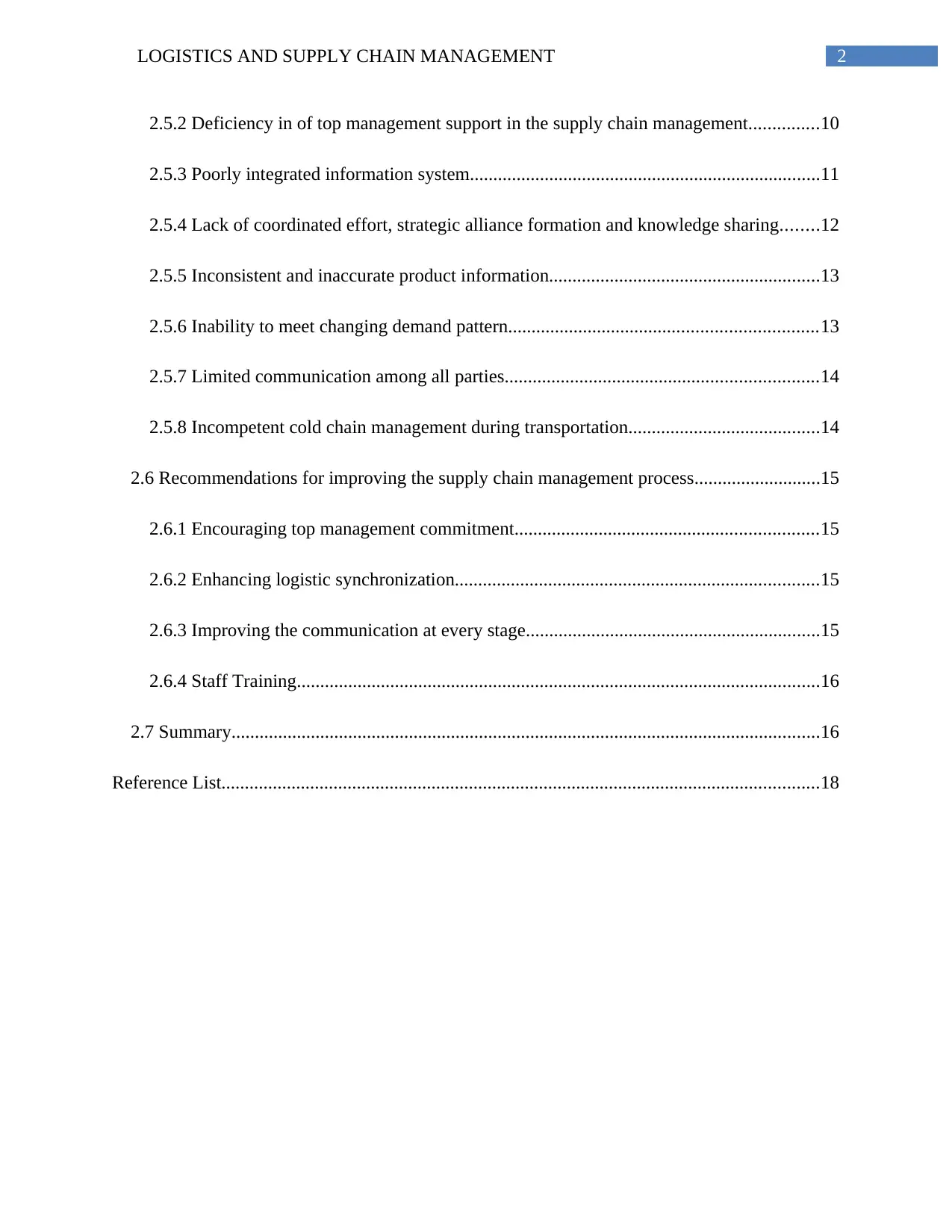
2LOGISTICS AND SUPPLY CHAIN MANAGEMENT
2.5.2 Deficiency in of top management support in the supply chain management...............10
2.5.3 Poorly integrated information system...........................................................................11
2.5.4 Lack of coordinated effort, strategic alliance formation and knowledge sharing........12
2.5.5 Inconsistent and inaccurate product information..........................................................13
2.5.6 Inability to meet changing demand pattern..................................................................13
2.5.7 Limited communication among all parties...................................................................14
2.5.8 Incompetent cold chain management during transportation.........................................14
2.6 Recommendations for improving the supply chain management process...........................15
2.6.1 Encouraging top management commitment.................................................................15
2.6.2 Enhancing logistic synchronization..............................................................................15
2.6.3 Improving the communication at every stage...............................................................15
2.6.4 Staff Training................................................................................................................16
2.7 Summary..............................................................................................................................16
Reference List................................................................................................................................18
2.5.2 Deficiency in of top management support in the supply chain management...............10
2.5.3 Poorly integrated information system...........................................................................11
2.5.4 Lack of coordinated effort, strategic alliance formation and knowledge sharing........12
2.5.5 Inconsistent and inaccurate product information..........................................................13
2.5.6 Inability to meet changing demand pattern..................................................................13
2.5.7 Limited communication among all parties...................................................................14
2.5.8 Incompetent cold chain management during transportation.........................................14
2.6 Recommendations for improving the supply chain management process...........................15
2.6.1 Encouraging top management commitment.................................................................15
2.6.2 Enhancing logistic synchronization..............................................................................15
2.6.3 Improving the communication at every stage...............................................................15
2.6.4 Staff Training................................................................................................................16
2.7 Summary..............................................................................................................................16
Reference List................................................................................................................................18
⊘ This is a preview!⊘
Do you want full access?
Subscribe today to unlock all pages.

Trusted by 1+ million students worldwide
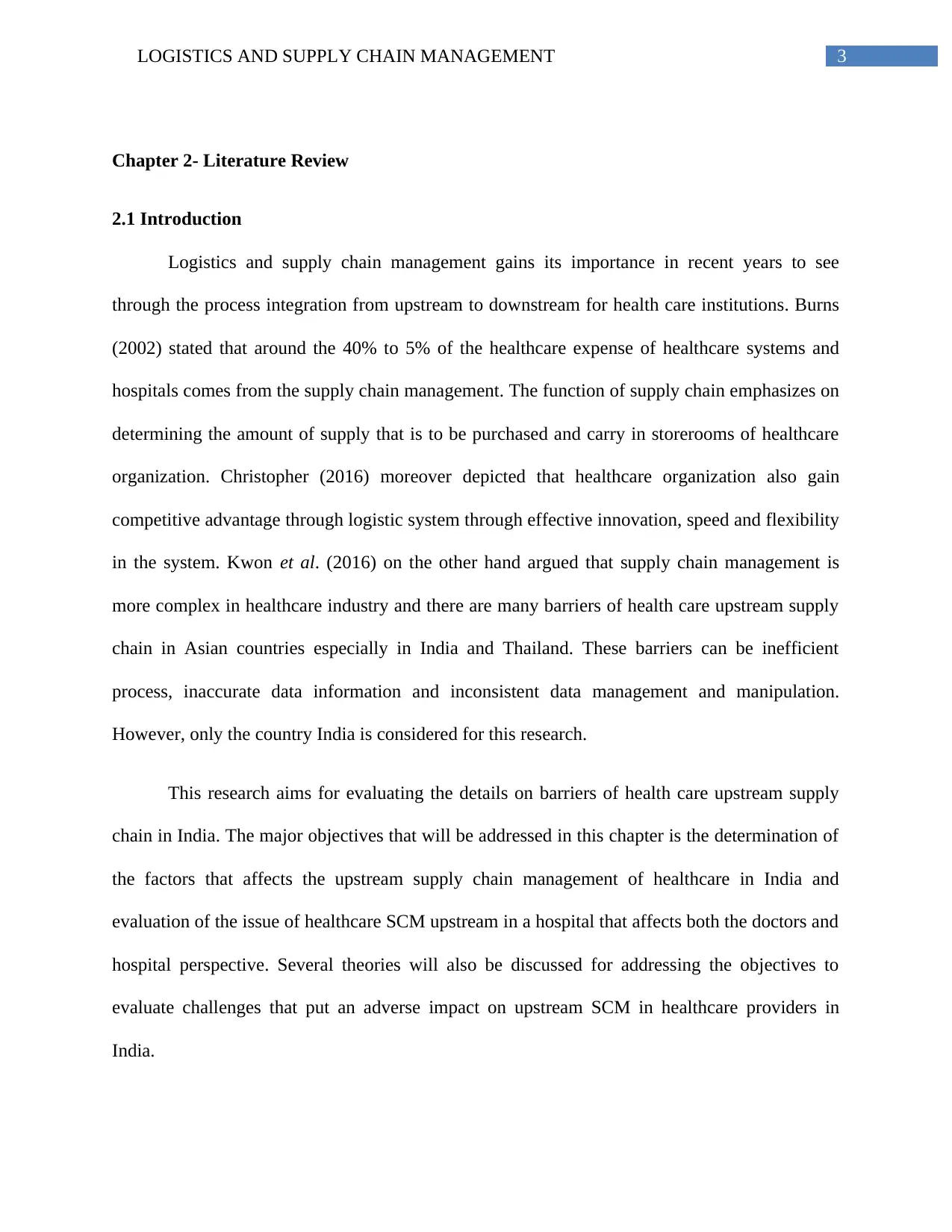
3LOGISTICS AND SUPPLY CHAIN MANAGEMENT
Chapter 2- Literature Review
2.1 Introduction
Logistics and supply chain management gains its importance in recent years to see
through the process integration from upstream to downstream for health care institutions. Burns
(2002) stated that around the 40% to 5% of the healthcare expense of healthcare systems and
hospitals comes from the supply chain management. The function of supply chain emphasizes on
determining the amount of supply that is to be purchased and carry in storerooms of healthcare
organization. Christopher (2016) moreover depicted that healthcare organization also gain
competitive advantage through logistic system through effective innovation, speed and flexibility
in the system. Kwon et al. (2016) on the other hand argued that supply chain management is
more complex in healthcare industry and there are many barriers of health care upstream supply
chain in Asian countries especially in India and Thailand. These barriers can be inefficient
process, inaccurate data information and inconsistent data management and manipulation.
However, only the country India is considered for this research.
This research aims for evaluating the details on barriers of health care upstream supply
chain in India. The major objectives that will be addressed in this chapter is the determination of
the factors that affects the upstream supply chain management of healthcare in India and
evaluation of the issue of healthcare SCM upstream in a hospital that affects both the doctors and
hospital perspective. Several theories will also be discussed for addressing the objectives to
evaluate challenges that put an adverse impact on upstream SCM in healthcare providers in
India.
Chapter 2- Literature Review
2.1 Introduction
Logistics and supply chain management gains its importance in recent years to see
through the process integration from upstream to downstream for health care institutions. Burns
(2002) stated that around the 40% to 5% of the healthcare expense of healthcare systems and
hospitals comes from the supply chain management. The function of supply chain emphasizes on
determining the amount of supply that is to be purchased and carry in storerooms of healthcare
organization. Christopher (2016) moreover depicted that healthcare organization also gain
competitive advantage through logistic system through effective innovation, speed and flexibility
in the system. Kwon et al. (2016) on the other hand argued that supply chain management is
more complex in healthcare industry and there are many barriers of health care upstream supply
chain in Asian countries especially in India and Thailand. These barriers can be inefficient
process, inaccurate data information and inconsistent data management and manipulation.
However, only the country India is considered for this research.
This research aims for evaluating the details on barriers of health care upstream supply
chain in India. The major objectives that will be addressed in this chapter is the determination of
the factors that affects the upstream supply chain management of healthcare in India and
evaluation of the issue of healthcare SCM upstream in a hospital that affects both the doctors and
hospital perspective. Several theories will also be discussed for addressing the objectives to
evaluate challenges that put an adverse impact on upstream SCM in healthcare providers in
India.
Paraphrase This Document
Need a fresh take? Get an instant paraphrase of this document with our AI Paraphraser
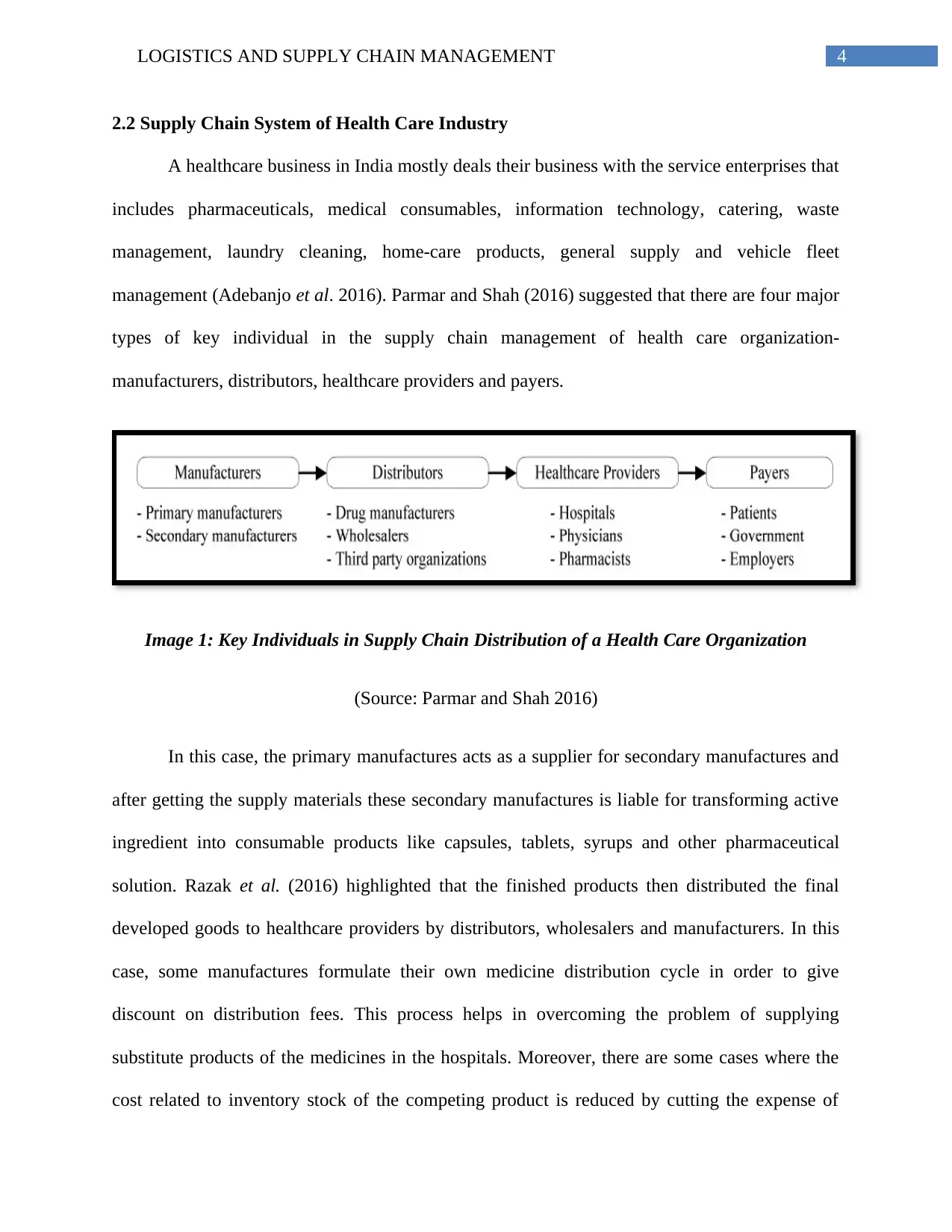
4LOGISTICS AND SUPPLY CHAIN MANAGEMENT
2.2 Supply Chain System of Health Care Industry
A healthcare business in India mostly deals their business with the service enterprises that
includes pharmaceuticals, medical consumables, information technology, catering, waste
management, laundry cleaning, home-care products, general supply and vehicle fleet
management (Adebanjo et al. 2016). Parmar and Shah (2016) suggested that there are four major
types of key individual in the supply chain management of health care organization-
manufacturers, distributors, healthcare providers and payers.
Image 1: Key Individuals in Supply Chain Distribution of a Health Care Organization
(Source: Parmar and Shah 2016)
In this case, the primary manufactures acts as a supplier for secondary manufactures and
after getting the supply materials these secondary manufactures is liable for transforming active
ingredient into consumable products like capsules, tablets, syrups and other pharmaceutical
solution. Razak et al. (2016) highlighted that the finished products then distributed the final
developed goods to healthcare providers by distributors, wholesalers and manufacturers. In this
case, some manufactures formulate their own medicine distribution cycle in order to give
discount on distribution fees. This process helps in overcoming the problem of supplying
substitute products of the medicines in the hospitals. Moreover, there are some cases where the
cost related to inventory stock of the competing product is reduced by cutting the expense of
2.2 Supply Chain System of Health Care Industry
A healthcare business in India mostly deals their business with the service enterprises that
includes pharmaceuticals, medical consumables, information technology, catering, waste
management, laundry cleaning, home-care products, general supply and vehicle fleet
management (Adebanjo et al. 2016). Parmar and Shah (2016) suggested that there are four major
types of key individual in the supply chain management of health care organization-
manufacturers, distributors, healthcare providers and payers.
Image 1: Key Individuals in Supply Chain Distribution of a Health Care Organization
(Source: Parmar and Shah 2016)
In this case, the primary manufactures acts as a supplier for secondary manufactures and
after getting the supply materials these secondary manufactures is liable for transforming active
ingredient into consumable products like capsules, tablets, syrups and other pharmaceutical
solution. Razak et al. (2016) highlighted that the finished products then distributed the final
developed goods to healthcare providers by distributors, wholesalers and manufacturers. In this
case, some manufactures formulate their own medicine distribution cycle in order to give
discount on distribution fees. This process helps in overcoming the problem of supplying
substitute products of the medicines in the hospitals. Moreover, there are some cases where the
cost related to inventory stock of the competing product is reduced by cutting the expense of
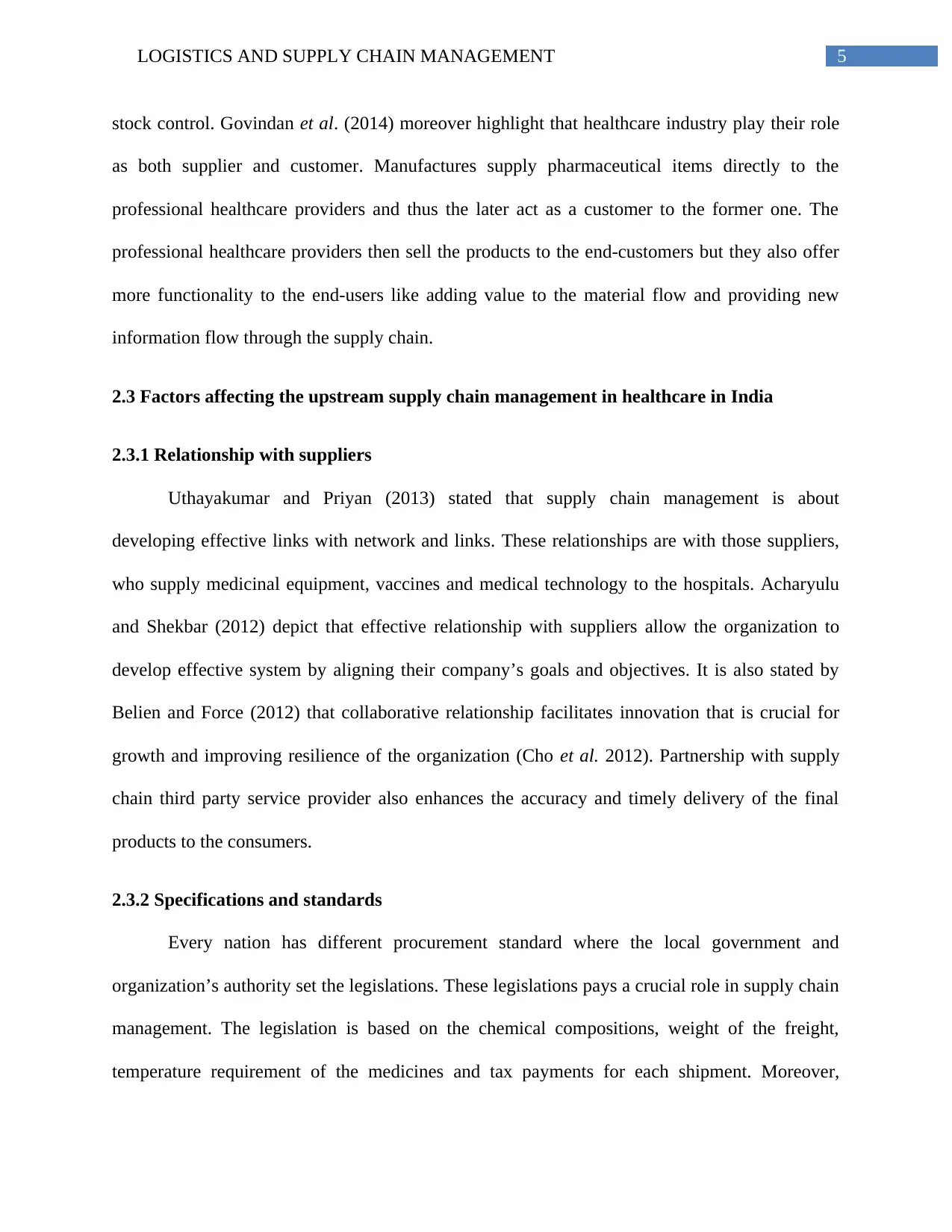
5LOGISTICS AND SUPPLY CHAIN MANAGEMENT
stock control. Govindan et al. (2014) moreover highlight that healthcare industry play their role
as both supplier and customer. Manufactures supply pharmaceutical items directly to the
professional healthcare providers and thus the later act as a customer to the former one. The
professional healthcare providers then sell the products to the end-customers but they also offer
more functionality to the end-users like adding value to the material flow and providing new
information flow through the supply chain.
2.3 Factors affecting the upstream supply chain management in healthcare in India
2.3.1 Relationship with suppliers
Uthayakumar and Priyan (2013) stated that supply chain management is about
developing effective links with network and links. These relationships are with those suppliers,
who supply medicinal equipment, vaccines and medical technology to the hospitals. Acharyulu
and Shekbar (2012) depict that effective relationship with suppliers allow the organization to
develop effective system by aligning their company’s goals and objectives. It is also stated by
Belien and Force (2012) that collaborative relationship facilitates innovation that is crucial for
growth and improving resilience of the organization (Cho et al. 2012). Partnership with supply
chain third party service provider also enhances the accuracy and timely delivery of the final
products to the consumers.
2.3.2 Specifications and standards
Every nation has different procurement standard where the local government and
organization’s authority set the legislations. These legislations pays a crucial role in supply chain
management. The legislation is based on the chemical compositions, weight of the freight,
temperature requirement of the medicines and tax payments for each shipment. Moreover,
stock control. Govindan et al. (2014) moreover highlight that healthcare industry play their role
as both supplier and customer. Manufactures supply pharmaceutical items directly to the
professional healthcare providers and thus the later act as a customer to the former one. The
professional healthcare providers then sell the products to the end-customers but they also offer
more functionality to the end-users like adding value to the material flow and providing new
information flow through the supply chain.
2.3 Factors affecting the upstream supply chain management in healthcare in India
2.3.1 Relationship with suppliers
Uthayakumar and Priyan (2013) stated that supply chain management is about
developing effective links with network and links. These relationships are with those suppliers,
who supply medicinal equipment, vaccines and medical technology to the hospitals. Acharyulu
and Shekbar (2012) depict that effective relationship with suppliers allow the organization to
develop effective system by aligning their company’s goals and objectives. It is also stated by
Belien and Force (2012) that collaborative relationship facilitates innovation that is crucial for
growth and improving resilience of the organization (Cho et al. 2012). Partnership with supply
chain third party service provider also enhances the accuracy and timely delivery of the final
products to the consumers.
2.3.2 Specifications and standards
Every nation has different procurement standard where the local government and
organization’s authority set the legislations. These legislations pays a crucial role in supply chain
management. The legislation is based on the chemical compositions, weight of the freight,
temperature requirement of the medicines and tax payments for each shipment. Moreover,
⊘ This is a preview!⊘
Do you want full access?
Subscribe today to unlock all pages.

Trusted by 1+ million students worldwide
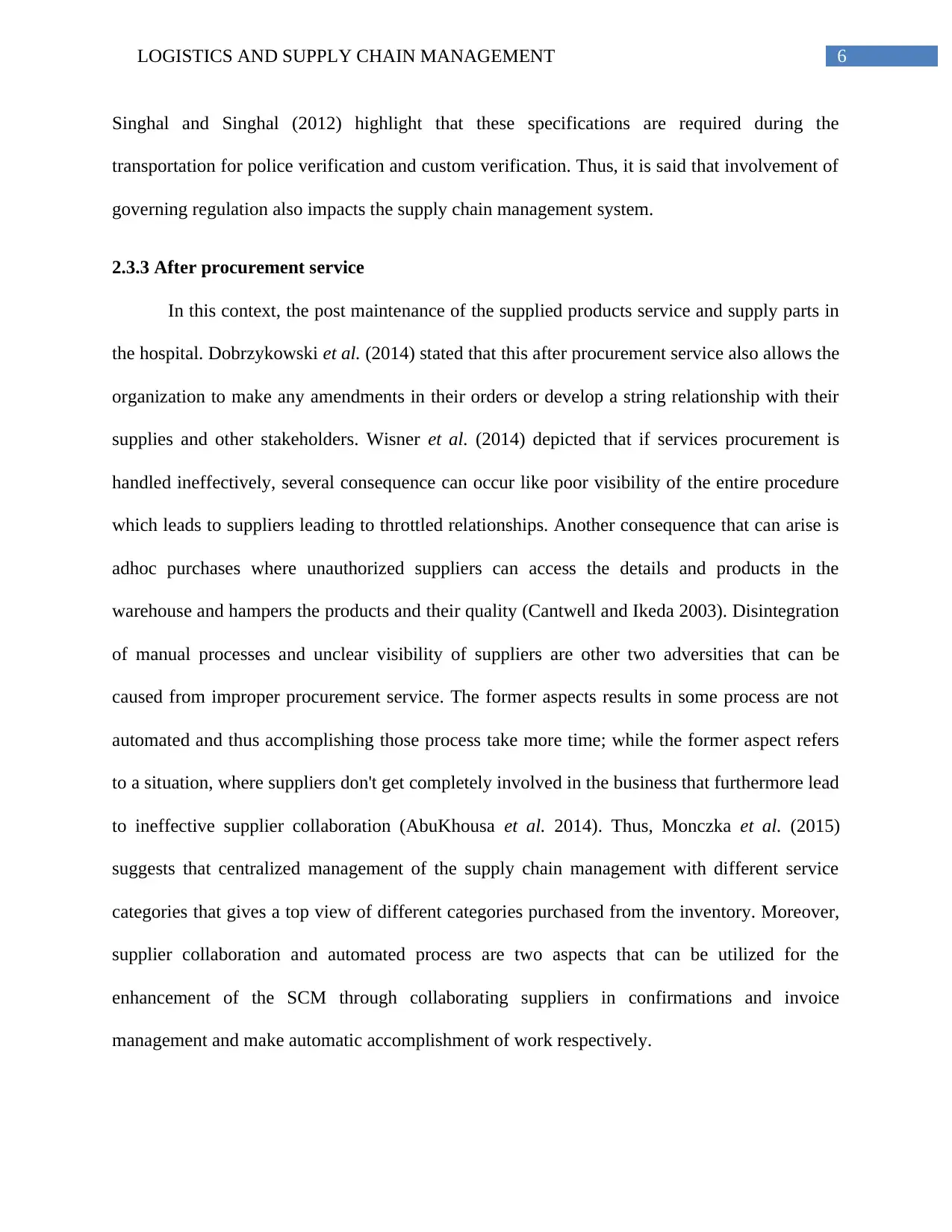
6LOGISTICS AND SUPPLY CHAIN MANAGEMENT
Singhal and Singhal (2012) highlight that these specifications are required during the
transportation for police verification and custom verification. Thus, it is said that involvement of
governing regulation also impacts the supply chain management system.
2.3.3 After procurement service
In this context, the post maintenance of the supplied products service and supply parts in
the hospital. Dobrzykowski et al. (2014) stated that this after procurement service also allows the
organization to make any amendments in their orders or develop a string relationship with their
supplies and other stakeholders. Wisner et al. (2014) depicted that if services procurement is
handled ineffectively, several consequence can occur like poor visibility of the entire procedure
which leads to suppliers leading to throttled relationships. Another consequence that can arise is
adhoc purchases where unauthorized suppliers can access the details and products in the
warehouse and hampers the products and their quality (Cantwell and Ikeda 2003). Disintegration
of manual processes and unclear visibility of suppliers are other two adversities that can be
caused from improper procurement service. The former aspects results in some process are not
automated and thus accomplishing those process take more time; while the former aspect refers
to a situation, where suppliers don't get completely involved in the business that furthermore lead
to ineffective supplier collaboration (AbuKhousa et al. 2014). Thus, Monczka et al. (2015)
suggests that centralized management of the supply chain management with different service
categories that gives a top view of different categories purchased from the inventory. Moreover,
supplier collaboration and automated process are two aspects that can be utilized for the
enhancement of the SCM through collaborating suppliers in confirmations and invoice
management and make automatic accomplishment of work respectively.
Singhal and Singhal (2012) highlight that these specifications are required during the
transportation for police verification and custom verification. Thus, it is said that involvement of
governing regulation also impacts the supply chain management system.
2.3.3 After procurement service
In this context, the post maintenance of the supplied products service and supply parts in
the hospital. Dobrzykowski et al. (2014) stated that this after procurement service also allows the
organization to make any amendments in their orders or develop a string relationship with their
supplies and other stakeholders. Wisner et al. (2014) depicted that if services procurement is
handled ineffectively, several consequence can occur like poor visibility of the entire procedure
which leads to suppliers leading to throttled relationships. Another consequence that can arise is
adhoc purchases where unauthorized suppliers can access the details and products in the
warehouse and hampers the products and their quality (Cantwell and Ikeda 2003). Disintegration
of manual processes and unclear visibility of suppliers are other two adversities that can be
caused from improper procurement service. The former aspects results in some process are not
automated and thus accomplishing those process take more time; while the former aspect refers
to a situation, where suppliers don't get completely involved in the business that furthermore lead
to ineffective supplier collaboration (AbuKhousa et al. 2014). Thus, Monczka et al. (2015)
suggests that centralized management of the supply chain management with different service
categories that gives a top view of different categories purchased from the inventory. Moreover,
supplier collaboration and automated process are two aspects that can be utilized for the
enhancement of the SCM through collaborating suppliers in confirmations and invoice
management and make automatic accomplishment of work respectively.
Paraphrase This Document
Need a fresh take? Get an instant paraphrase of this document with our AI Paraphraser
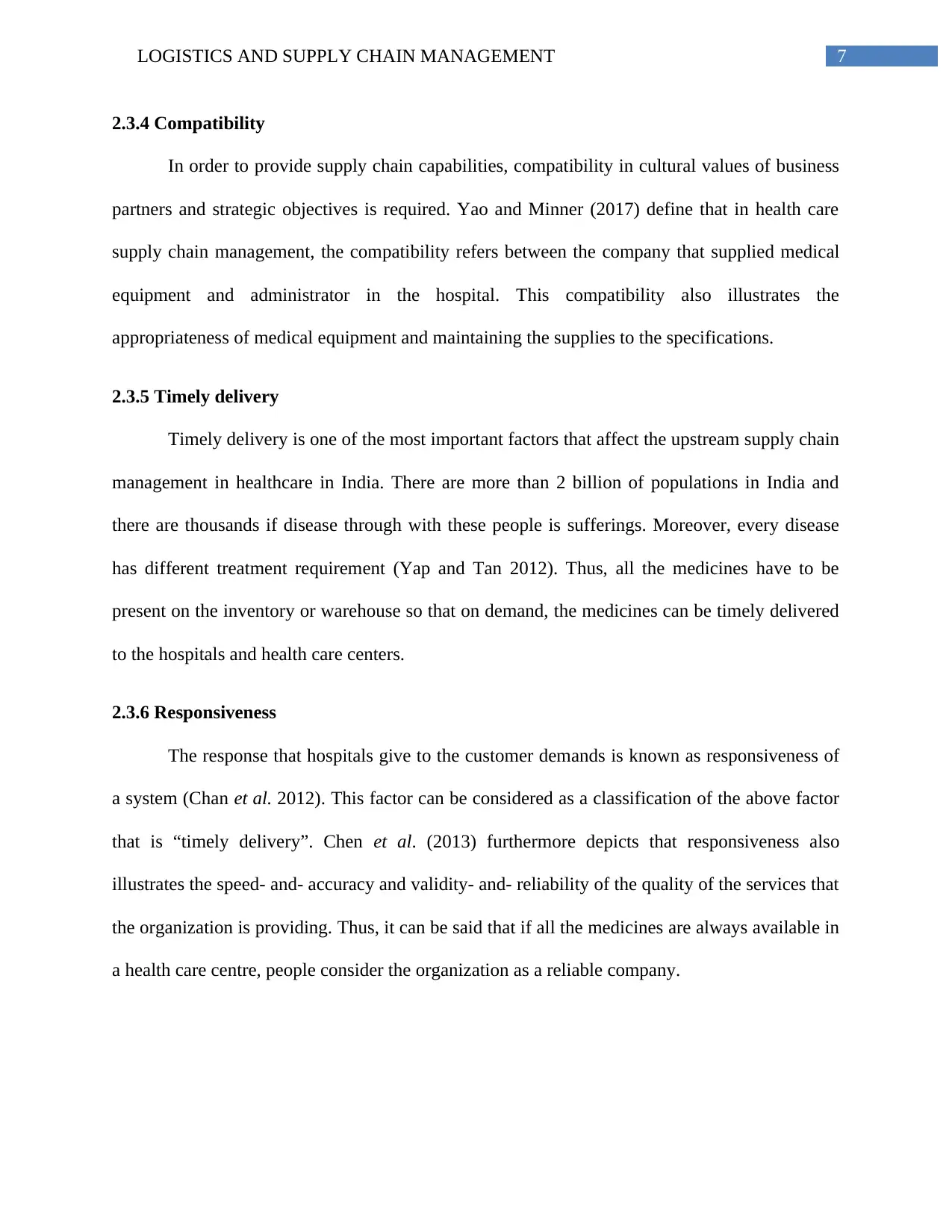
7LOGISTICS AND SUPPLY CHAIN MANAGEMENT
2.3.4 Compatibility
In order to provide supply chain capabilities, compatibility in cultural values of business
partners and strategic objectives is required. Yao and Minner (2017) define that in health care
supply chain management, the compatibility refers between the company that supplied medical
equipment and administrator in the hospital. This compatibility also illustrates the
appropriateness of medical equipment and maintaining the supplies to the specifications.
2.3.5 Timely delivery
Timely delivery is one of the most important factors that affect the upstream supply chain
management in healthcare in India. There are more than 2 billion of populations in India and
there are thousands if disease through with these people is sufferings. Moreover, every disease
has different treatment requirement (Yap and Tan 2012). Thus, all the medicines have to be
present on the inventory or warehouse so that on demand, the medicines can be timely delivered
to the hospitals and health care centers.
2.3.6 Responsiveness
The response that hospitals give to the customer demands is known as responsiveness of
a system (Chan et al. 2012). This factor can be considered as a classification of the above factor
that is “timely delivery”. Chen et al. (2013) furthermore depicts that responsiveness also
illustrates the speed- and- accuracy and validity- and- reliability of the quality of the services that
the organization is providing. Thus, it can be said that if all the medicines are always available in
a health care centre, people consider the organization as a reliable company.
2.3.4 Compatibility
In order to provide supply chain capabilities, compatibility in cultural values of business
partners and strategic objectives is required. Yao and Minner (2017) define that in health care
supply chain management, the compatibility refers between the company that supplied medical
equipment and administrator in the hospital. This compatibility also illustrates the
appropriateness of medical equipment and maintaining the supplies to the specifications.
2.3.5 Timely delivery
Timely delivery is one of the most important factors that affect the upstream supply chain
management in healthcare in India. There are more than 2 billion of populations in India and
there are thousands if disease through with these people is sufferings. Moreover, every disease
has different treatment requirement (Yap and Tan 2012). Thus, all the medicines have to be
present on the inventory or warehouse so that on demand, the medicines can be timely delivered
to the hospitals and health care centers.
2.3.6 Responsiveness
The response that hospitals give to the customer demands is known as responsiveness of
a system (Chan et al. 2012). This factor can be considered as a classification of the above factor
that is “timely delivery”. Chen et al. (2013) furthermore depicts that responsiveness also
illustrates the speed- and- accuracy and validity- and- reliability of the quality of the services that
the organization is providing. Thus, it can be said that if all the medicines are always available in
a health care centre, people consider the organization as a reliable company.
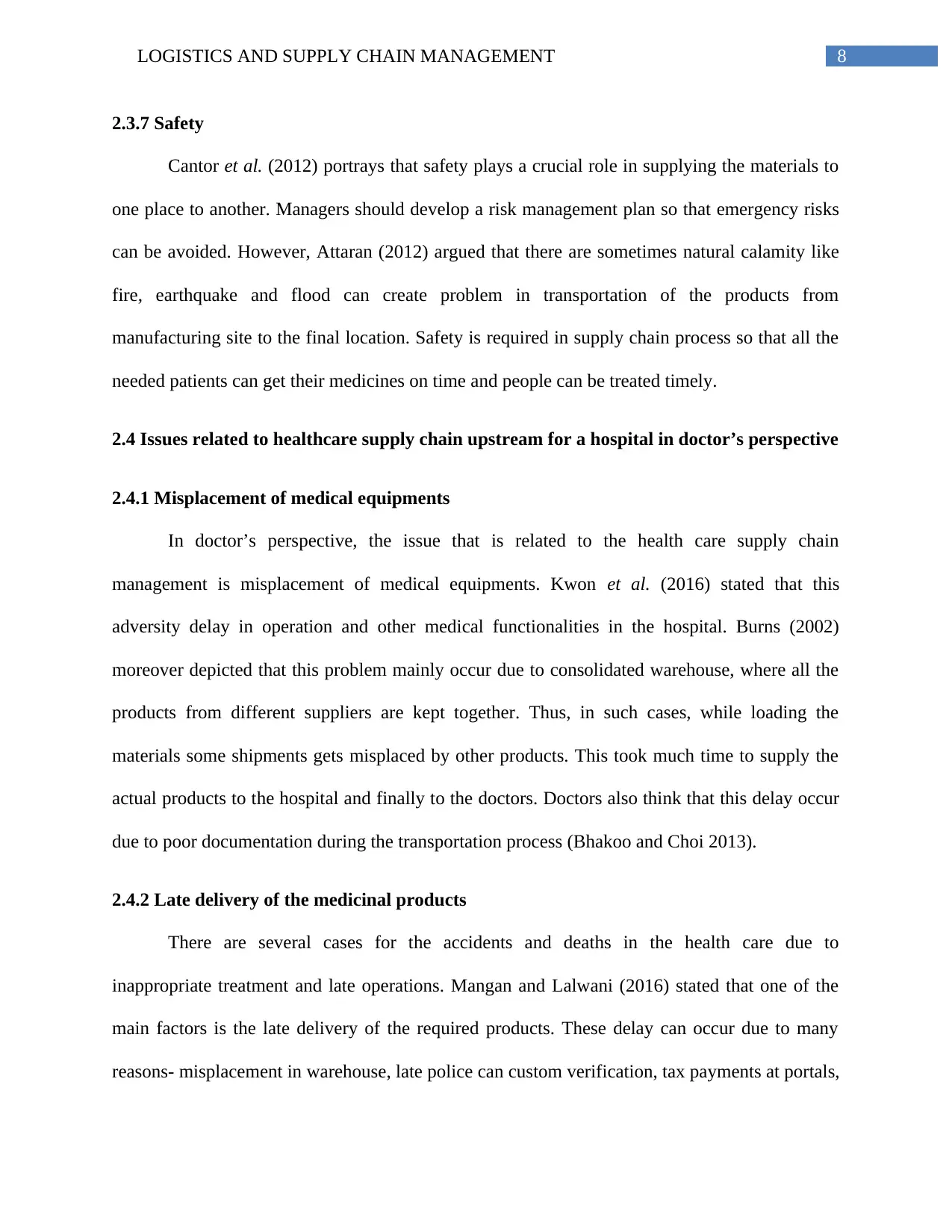
8LOGISTICS AND SUPPLY CHAIN MANAGEMENT
2.3.7 Safety
Cantor et al. (2012) portrays that safety plays a crucial role in supplying the materials to
one place to another. Managers should develop a risk management plan so that emergency risks
can be avoided. However, Attaran (2012) argued that there are sometimes natural calamity like
fire, earthquake and flood can create problem in transportation of the products from
manufacturing site to the final location. Safety is required in supply chain process so that all the
needed patients can get their medicines on time and people can be treated timely.
2.4 Issues related to healthcare supply chain upstream for a hospital in doctor’s perspective
2.4.1 Misplacement of medical equipments
In doctor’s perspective, the issue that is related to the health care supply chain
management is misplacement of medical equipments. Kwon et al. (2016) stated that this
adversity delay in operation and other medical functionalities in the hospital. Burns (2002)
moreover depicted that this problem mainly occur due to consolidated warehouse, where all the
products from different suppliers are kept together. Thus, in such cases, while loading the
materials some shipments gets misplaced by other products. This took much time to supply the
actual products to the hospital and finally to the doctors. Doctors also think that this delay occur
due to poor documentation during the transportation process (Bhakoo and Choi 2013).
2.4.2 Late delivery of the medicinal products
There are several cases for the accidents and deaths in the health care due to
inappropriate treatment and late operations. Mangan and Lalwani (2016) stated that one of the
main factors is the late delivery of the required products. These delay can occur due to many
reasons- misplacement in warehouse, late police can custom verification, tax payments at portals,
2.3.7 Safety
Cantor et al. (2012) portrays that safety plays a crucial role in supplying the materials to
one place to another. Managers should develop a risk management plan so that emergency risks
can be avoided. However, Attaran (2012) argued that there are sometimes natural calamity like
fire, earthquake and flood can create problem in transportation of the products from
manufacturing site to the final location. Safety is required in supply chain process so that all the
needed patients can get their medicines on time and people can be treated timely.
2.4 Issues related to healthcare supply chain upstream for a hospital in doctor’s perspective
2.4.1 Misplacement of medical equipments
In doctor’s perspective, the issue that is related to the health care supply chain
management is misplacement of medical equipments. Kwon et al. (2016) stated that this
adversity delay in operation and other medical functionalities in the hospital. Burns (2002)
moreover depicted that this problem mainly occur due to consolidated warehouse, where all the
products from different suppliers are kept together. Thus, in such cases, while loading the
materials some shipments gets misplaced by other products. This took much time to supply the
actual products to the hospital and finally to the doctors. Doctors also think that this delay occur
due to poor documentation during the transportation process (Bhakoo and Choi 2013).
2.4.2 Late delivery of the medicinal products
There are several cases for the accidents and deaths in the health care due to
inappropriate treatment and late operations. Mangan and Lalwani (2016) stated that one of the
main factors is the late delivery of the required products. These delay can occur due to many
reasons- misplacement in warehouse, late police can custom verification, tax payments at portals,
⊘ This is a preview!⊘
Do you want full access?
Subscribe today to unlock all pages.

Trusted by 1+ million students worldwide
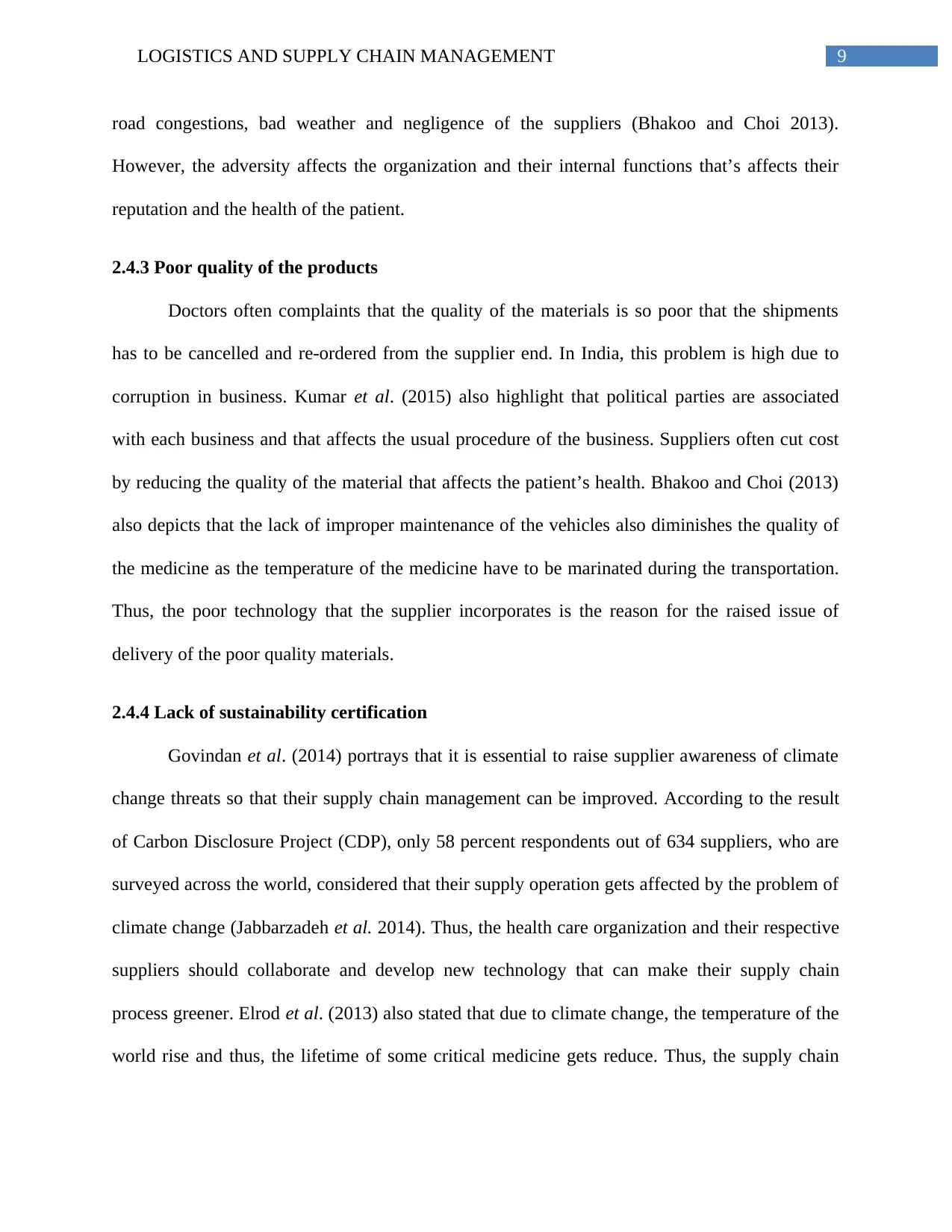
9LOGISTICS AND SUPPLY CHAIN MANAGEMENT
road congestions, bad weather and negligence of the suppliers (Bhakoo and Choi 2013).
However, the adversity affects the organization and their internal functions that’s affects their
reputation and the health of the patient.
2.4.3 Poor quality of the products
Doctors often complaints that the quality of the materials is so poor that the shipments
has to be cancelled and re-ordered from the supplier end. In India, this problem is high due to
corruption in business. Kumar et al. (2015) also highlight that political parties are associated
with each business and that affects the usual procedure of the business. Suppliers often cut cost
by reducing the quality of the material that affects the patient’s health. Bhakoo and Choi (2013)
also depicts that the lack of improper maintenance of the vehicles also diminishes the quality of
the medicine as the temperature of the medicine have to be marinated during the transportation.
Thus, the poor technology that the supplier incorporates is the reason for the raised issue of
delivery of the poor quality materials.
2.4.4 Lack of sustainability certification
Govindan et al. (2014) portrays that it is essential to raise supplier awareness of climate
change threats so that their supply chain management can be improved. According to the result
of Carbon Disclosure Project (CDP), only 58 percent respondents out of 634 suppliers, who are
surveyed across the world, considered that their supply operation gets affected by the problem of
climate change (Jabbarzadeh et al. 2014). Thus, the health care organization and their respective
suppliers should collaborate and develop new technology that can make their supply chain
process greener. Elrod et al. (2013) also stated that due to climate change, the temperature of the
world rise and thus, the lifetime of some critical medicine gets reduce. Thus, the supply chain
road congestions, bad weather and negligence of the suppliers (Bhakoo and Choi 2013).
However, the adversity affects the organization and their internal functions that’s affects their
reputation and the health of the patient.
2.4.3 Poor quality of the products
Doctors often complaints that the quality of the materials is so poor that the shipments
has to be cancelled and re-ordered from the supplier end. In India, this problem is high due to
corruption in business. Kumar et al. (2015) also highlight that political parties are associated
with each business and that affects the usual procedure of the business. Suppliers often cut cost
by reducing the quality of the material that affects the patient’s health. Bhakoo and Choi (2013)
also depicts that the lack of improper maintenance of the vehicles also diminishes the quality of
the medicine as the temperature of the medicine have to be marinated during the transportation.
Thus, the poor technology that the supplier incorporates is the reason for the raised issue of
delivery of the poor quality materials.
2.4.4 Lack of sustainability certification
Govindan et al. (2014) portrays that it is essential to raise supplier awareness of climate
change threats so that their supply chain management can be improved. According to the result
of Carbon Disclosure Project (CDP), only 58 percent respondents out of 634 suppliers, who are
surveyed across the world, considered that their supply operation gets affected by the problem of
climate change (Jabbarzadeh et al. 2014). Thus, the health care organization and their respective
suppliers should collaborate and develop new technology that can make their supply chain
process greener. Elrod et al. (2013) also stated that due to climate change, the temperature of the
world rise and thus, the lifetime of some critical medicine gets reduce. Thus, the supply chain
Paraphrase This Document
Need a fresh take? Get an instant paraphrase of this document with our AI Paraphraser
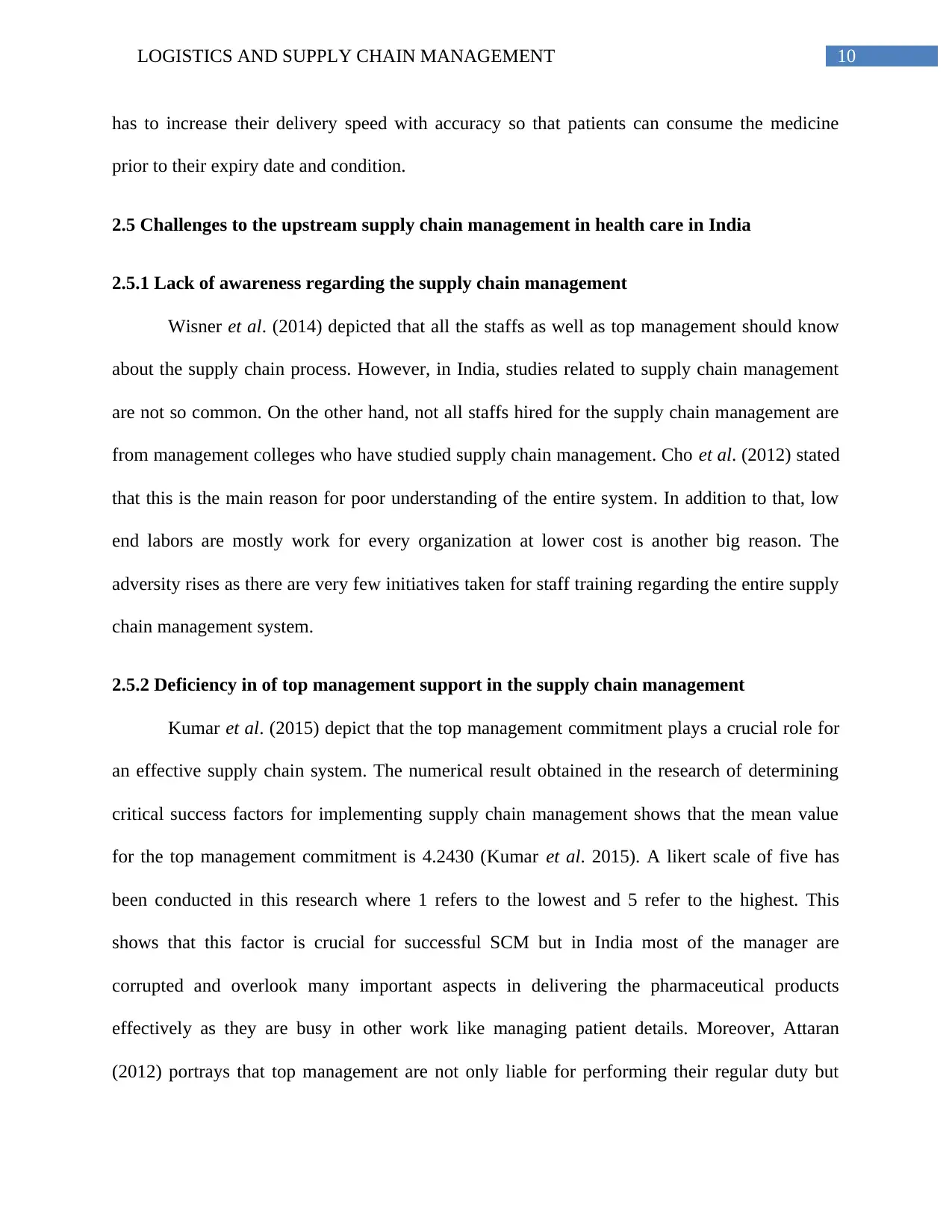
10LOGISTICS AND SUPPLY CHAIN MANAGEMENT
has to increase their delivery speed with accuracy so that patients can consume the medicine
prior to their expiry date and condition.
2.5 Challenges to the upstream supply chain management in health care in India
2.5.1 Lack of awareness regarding the supply chain management
Wisner et al. (2014) depicted that all the staffs as well as top management should know
about the supply chain process. However, in India, studies related to supply chain management
are not so common. On the other hand, not all staffs hired for the supply chain management are
from management colleges who have studied supply chain management. Cho et al. (2012) stated
that this is the main reason for poor understanding of the entire system. In addition to that, low
end labors are mostly work for every organization at lower cost is another big reason. The
adversity rises as there are very few initiatives taken for staff training regarding the entire supply
chain management system.
2.5.2 Deficiency in of top management support in the supply chain management
Kumar et al. (2015) depict that the top management commitment plays a crucial role for
an effective supply chain system. The numerical result obtained in the research of determining
critical success factors for implementing supply chain management shows that the mean value
for the top management commitment is 4.2430 (Kumar et al. 2015). A likert scale of five has
been conducted in this research where 1 refers to the lowest and 5 refer to the highest. This
shows that this factor is crucial for successful SCM but in India most of the manager are
corrupted and overlook many important aspects in delivering the pharmaceutical products
effectively as they are busy in other work like managing patient details. Moreover, Attaran
(2012) portrays that top management are not only liable for performing their regular duty but
has to increase their delivery speed with accuracy so that patients can consume the medicine
prior to their expiry date and condition.
2.5 Challenges to the upstream supply chain management in health care in India
2.5.1 Lack of awareness regarding the supply chain management
Wisner et al. (2014) depicted that all the staffs as well as top management should know
about the supply chain process. However, in India, studies related to supply chain management
are not so common. On the other hand, not all staffs hired for the supply chain management are
from management colleges who have studied supply chain management. Cho et al. (2012) stated
that this is the main reason for poor understanding of the entire system. In addition to that, low
end labors are mostly work for every organization at lower cost is another big reason. The
adversity rises as there are very few initiatives taken for staff training regarding the entire supply
chain management system.
2.5.2 Deficiency in of top management support in the supply chain management
Kumar et al. (2015) depict that the top management commitment plays a crucial role for
an effective supply chain system. The numerical result obtained in the research of determining
critical success factors for implementing supply chain management shows that the mean value
for the top management commitment is 4.2430 (Kumar et al. 2015). A likert scale of five has
been conducted in this research where 1 refers to the lowest and 5 refer to the highest. This
shows that this factor is crucial for successful SCM but in India most of the manager are
corrupted and overlook many important aspects in delivering the pharmaceutical products
effectively as they are busy in other work like managing patient details. Moreover, Attaran
(2012) portrays that top management are not only liable for performing their regular duty but
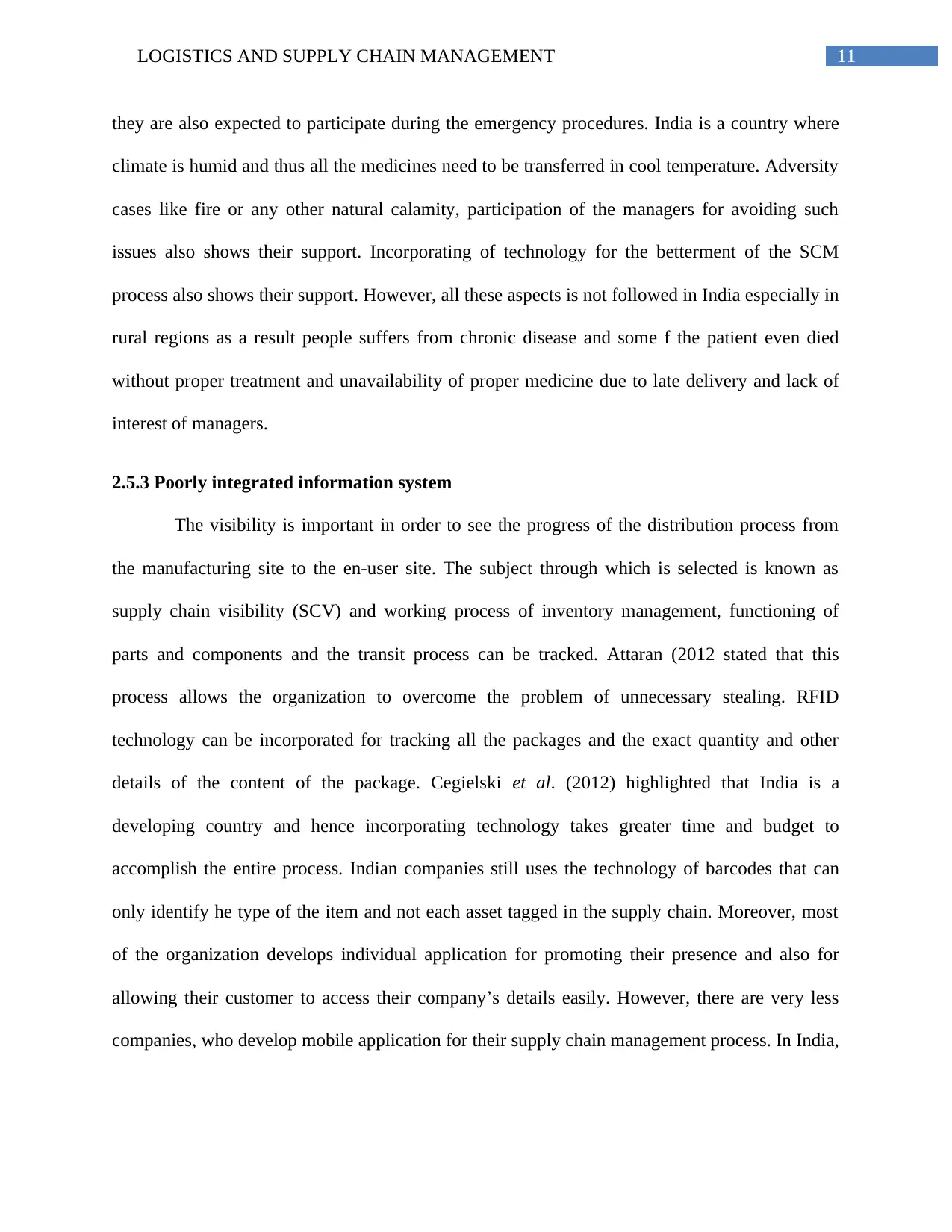
11LOGISTICS AND SUPPLY CHAIN MANAGEMENT
they are also expected to participate during the emergency procedures. India is a country where
climate is humid and thus all the medicines need to be transferred in cool temperature. Adversity
cases like fire or any other natural calamity, participation of the managers for avoiding such
issues also shows their support. Incorporating of technology for the betterment of the SCM
process also shows their support. However, all these aspects is not followed in India especially in
rural regions as a result people suffers from chronic disease and some f the patient even died
without proper treatment and unavailability of proper medicine due to late delivery and lack of
interest of managers.
2.5.3 Poorly integrated information system
The visibility is important in order to see the progress of the distribution process from
the manufacturing site to the en-user site. The subject through which is selected is known as
supply chain visibility (SCV) and working process of inventory management, functioning of
parts and components and the transit process can be tracked. Attaran (2012 stated that this
process allows the organization to overcome the problem of unnecessary stealing. RFID
technology can be incorporated for tracking all the packages and the exact quantity and other
details of the content of the package. Cegielski et al. (2012) highlighted that India is a
developing country and hence incorporating technology takes greater time and budget to
accomplish the entire process. Indian companies still uses the technology of barcodes that can
only identify he type of the item and not each asset tagged in the supply chain. Moreover, most
of the organization develops individual application for promoting their presence and also for
allowing their customer to access their company’s details easily. However, there are very less
companies, who develop mobile application for their supply chain management process. In India,
they are also expected to participate during the emergency procedures. India is a country where
climate is humid and thus all the medicines need to be transferred in cool temperature. Adversity
cases like fire or any other natural calamity, participation of the managers for avoiding such
issues also shows their support. Incorporating of technology for the betterment of the SCM
process also shows their support. However, all these aspects is not followed in India especially in
rural regions as a result people suffers from chronic disease and some f the patient even died
without proper treatment and unavailability of proper medicine due to late delivery and lack of
interest of managers.
2.5.3 Poorly integrated information system
The visibility is important in order to see the progress of the distribution process from
the manufacturing site to the en-user site. The subject through which is selected is known as
supply chain visibility (SCV) and working process of inventory management, functioning of
parts and components and the transit process can be tracked. Attaran (2012 stated that this
process allows the organization to overcome the problem of unnecessary stealing. RFID
technology can be incorporated for tracking all the packages and the exact quantity and other
details of the content of the package. Cegielski et al. (2012) highlighted that India is a
developing country and hence incorporating technology takes greater time and budget to
accomplish the entire process. Indian companies still uses the technology of barcodes that can
only identify he type of the item and not each asset tagged in the supply chain. Moreover, most
of the organization develops individual application for promoting their presence and also for
allowing their customer to access their company’s details easily. However, there are very less
companies, who develop mobile application for their supply chain management process. In India,
⊘ This is a preview!⊘
Do you want full access?
Subscribe today to unlock all pages.

Trusted by 1+ million students worldwide
1 out of 23
Related Documents
Your All-in-One AI-Powered Toolkit for Academic Success.
+13062052269
info@desklib.com
Available 24*7 on WhatsApp / Email
![[object Object]](/_next/static/media/star-bottom.7253800d.svg)
Unlock your academic potential
Copyright © 2020–2025 A2Z Services. All Rights Reserved. Developed and managed by ZUCOL.




